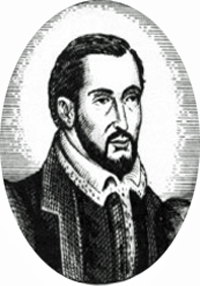Fernando de Rojas facts for kids
Quick facts for kids
Fernando de Rojas
|
|
|---|---|

Rojas by unknown contemporary artist
|
|
| Mayor of Talavera de la Reina, 1530s | |
| Personal details | |
| Born | c. 1465/73 La Puebla de Montalbán, Toledo, Spain |
| Died | April , 1541 (aged 67-68 or 75-76) Talavera de la Reina, Toledo, Spain |
| Spouse | Leonor Álvarez de Montalbán |
| Children | 7 |
| Alma mater | University of Salamanca |
| Occupation | Author, dramatist, lawyer |
| Known for | Writing La Celestina (1499) |
Fernando de Rojas (born around 1465/73 in La Puebla de Montalbán, Toledo, Spain – died April 1541 in Talavera de la Reina, Toledo, Spain) was an important Spanish writer and playwright. He is famous for his only known work, La Celestina. This book was first published in 1499.
Some people think La Celestina was the last major work of the Spanish Middle Ages. Others believe it was the first big work of the Spanish Renaissance. Rojas wrote this famous book when he was still a student.
After finishing his studies, Rojas became a lawyer. He did not write any more books that we know of. However, La Celestina became very popular during his lifetime. Rojas was a successful lawyer. He even became the mayor of Talavera de la Reina. He lived there for the last 30 years of his life.
Contents
Life and Early Career
Fernando de Rojas was born in La Puebla de Montalbán, Toledo. His family had Jewish roots. In Spain at that time, people from Jewish families who had converted to Christianity were called "conversos."
Being a converso did not stop people from moving up in society. Rojas's family had been recognized as hidalgos for many generations. This meant they were part of the lower nobility. However, converso families often faced scrutiny from the Inquisition. This was a special court that looked into people's religious beliefs.
Education and La Celestina
Rojas studied law at the University of Salamanca. He finished his studies around 1498. While he was at the university, he started writing La Celestina. The book was first published in 1499.
La Celestina is a very unique book. Some call it a play, others a novel with lots of talking. It was never performed on a stage when Rojas was alive. But today, most experts see it as a play. It is considered a very important work in Spanish literature. It is the only book Rojas is known to have written.
Family Life and Challenges
After university, Rojas returned home. His family faced some scrutiny from the Inquisition. However, Rojas himself was never suspected of secretly practicing Judaism.
Many conversos chose to marry into families with a long history of being Christian. This was a way to avoid problems. Rojas, however, married into another converso family. His wife was Leonor Álvarez de Montalbán. They had seven children together: four sons and three daughters.
Later Life and Public Service
Around 1507, Rojas moved to the city of Talavera de la Reina. There, he worked as a lawyer. His father-in-law, Álvaro de Montalbán, faced scrutiny from the Inquisition in 1525. Rojas was not allowed to be his lawyer, likely because Rojas was also a converso.
However, Rojas was allowed to speak on his father-in-law's behalf. The issue was then resolved. This shows that Rojas was respected, even with his family background. Rojas later served as the mayor of Talavera de la Reina in the 1530s. He was a successful lawyer and a respected public figure.
See also
 In Spanish: Fernando de Rojas para niños
In Spanish: Fernando de Rojas para niños

